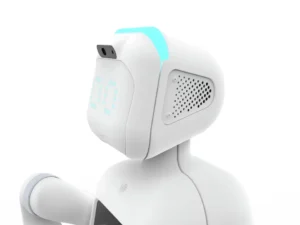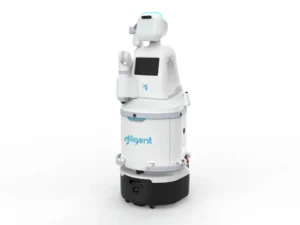The Austin company unveiled Moxi 2.0 at Nvidia Corp.’s GTC artificial intelligence conference in Washington, D.C. The robots run on Nvidia’s AI chips.
After spending most of their careers in academia, Andrea Thomaz and Vivian Chu began exploring how robots could be used in real-world, human-centered work environments.
Supported by Thomaz’s role at the University of Texas and government research grants, the pair relocated to Austin to observe hospital operations and explore practical uses for robotics.
“We were really trying to understand what took staff away from the bedside,” Chu said. “We saw firsthand and research shows that hospital staff spend about 30% of their time just fetching and gathering things, which is nowhere near what you need your nursing license for.”
After logging more than 150 hours of hospital shadowing, Thomaz and Chu founded Diligent Robotics in 2017 and began developing their first robot, Moxi, which is designed to work alongside hospital staff in high-pressure environments. Moxi helps nurses and pharmacy staff, two of the most understaffed groups in healthcare, by handling routine tasks such as delivering medications and transporting lab samples.

Diligent Robotics, since its founding in 2017, has built AI-powered robots to work alongside humans in healthcare settings. The company has delivered over 500,000 deliveries to operate in more than 25 hospitals nationwide.
The Austin company has deployed the robots in 25 hospitals nationwide. After collecting three years worth of data from 1.25 million deliveries inside hospitals, Diligent unveiled its next-generation robot, Moxi 2.0, on Tuesday at Nvidia’s GTC AI conference in Washington, D.C.
Diligent, which builds its robots on Nvidia Corp.’s AI chips, was featured in CEO Jensen Huang’s keynote speech. The new version of the robot is designed to help the company expand from about 100 deployed units to thousands.
“Moxi 2.0 is our next generation robot that we want to scale,” said Chu, who is now Diligent’s chief innovation officer. “We currently have nearly 100 robots in the world. Moxi 2.0 is what’s going to let us get beyond hundreds into the thousands.”
Chu said the company used data collected over the past three years, along with feedback from Moxi 1.0’s human coworkers, to design its next robot. She said Moxi 2.0 keeps the same socially expressive head and face, which many nurses say bring joy to their workday. The robots still move through hospital environments at walking speed and retain their extendable arm, drawers and wheels.
The new model has a similar look and feel but includes design tweaks based on hospital staff feedback. Moxi 2.0 has larger, curved drawers to better fit bins. The drawers now feature sturdier handles and bumpers have been added to the bottom of each robot. Handles were also added to the sides for easier maneuvering. The biggest change is inside: Moxi 2.0 has 10 times the computing power of its predecessor.
“The robot will feel a lot more natural and reactive,” Chu said. “By having more compute and running our next generation models on the robot, we can do things like use world models to predict what’s going to happen next as opposed to react to what’s unfolding.”

Diligent Robotics unveiled Moxi 2.0, its next-generation artificial intelligence platform, on Tuesday, Oct. 28, 2025, during Nvidia’s global AI conference in Washington D.C.
Chu used the example of a hospital elevator lobby. Instead of the robot moving only after an elevator’s doors open fully and the car is empty, Moxi 2.0 will now be able to predict which elevator will open, when it will open and begin moving toward it ahead of time, much like a human would.
The company plans to double its hospital presence each year and deploy more than 15 robots per hospital. Its long-term goal is to have thousands of Moxi 2.0 robots operating by 2030. With the added computing power, Diligent is already developing future updates, including voice commands and the ability for the robots to hold longer, more natural conversations.
The company is also exploring opportunities in new industries, particularly assisted living and senior care facilities. Earlier this month, the company was accepted into AARP’s AgeTech Collaborative, a program designed to support and aid tech startups expansions into senior living and long-term care communities.
The company also made several notable hires over the summer. Two former executives from General Motors’ autonomous vehicle subsidiary Cruise, Rashed Haq and Todd Brugger, joined Diligent as chief technology officer and chief operating officer, respectively. Their roles will support the company’s autonomous systems deployment, AI roadmap and commercial strategy as Diligent expands into new industries.
“We don’t have specifics yet,” Chu said, “but we’re exploring what other more complex manipulation we’re imagining in new scenarios, as opposed to just point-to-point deliveries that our robot does today. And that’s really what the next unlock on the compute will allow us to do, more complex manipulation.”
This release was originally shared via Austin American-Statesman on October 28, 2025. View the original release here.








